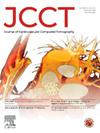Prognostic value of plaque burden assessed by coronary CT angiography in known coronary artery disease
IF 5.8
2区 医学
Q1 CARDIAC & CARDIOVASCULAR SYSTEMS
引用次数: 0
Abstract
Background
We aimed to investigate in patients with known coronary artery disease (CAD) whether plaque burden assessed by coronary computed tomography angiography (CCTA) can predict subsequent all-cause mortality (ACM).
Methods
Consecutive patients with known CAD who underwent CCTA and coronary artery calcium (CAC) scans for CAD evaluation were enrolled. Known CAD was defined as history of myocardial infarction (MI) or percutaneous coronary intervention (PCI). Plaque burden was assessed by CAC (categorized as 0–100, 101–300, 301–999, ≥1000), degree of stenosis (DS) (0–24 %, 25–49 %, 50–69 %, and ≥70 %) and segmental involvement score (SIS) (≤2, 3–4, 5–7, and ≥8) on CCTA. Multivariable Cox regression analysis was used to determine the association between plaque burden and ACM.
Results
963 patients were included (age 66.1 ± 11.5, 72.0 % male) of whom 707 had PCI, 586 had MI, and 330 had both. During median follow-up of 3.0 years (interquartile range 1.0–6.5), 91 patients (9.4 %) died. By Kaplan-Meier analysis, higher CAC score was associated with a higher risk of ACM (p < 0.001), but DS and SIS were not. In multivariable Cox regression analysis, CAC scores 301–999 (HR:3.10, 95%CI:1.23–7.80, p = 0.017) and ≥1000 (HR:5.81, 95%CI:2.25–15.04, p < 0.001) along with age, current smoking, and aspirin use were independently associated with increased risk of ACM, but DS and SIS were not.
Conclusion
In patients with known CAD undergoing CCTA, CAC score>300 was an independent predictor of ACM. CAC may provide additional guidance for the intensity of secondary preventive treatments than the degree of residual stenosis or the number of segments with CAD.

冠状动脉CT血管造影评估斑块负荷对已知冠状动脉疾病的预后价值。
背景:我们旨在研究已知冠状动脉疾病(CAD)患者通过冠状动脉计算机断层血管造影(CCTA)评估斑块负担是否可以预测随后的全因死亡率(ACM)。方法:连续接受CCTA和冠状动脉钙化(CAC)扫描的已知CAD患者进行CAD评估。已知的CAD被定义为心肌梗死(MI)或经皮冠状动脉介入治疗(PCI)史。通过CCTA上的CAC(分类为0- 100,101 - 300,301 -999,≥1000),狭窄程度(DS)(0- 24%, 25- 49%, 50- 69%和≥70%)和节段受累评分(SIS)(≤2,3 - 4,5 -7和≥8)来评估斑块负担。采用多变量Cox回归分析确定斑块负担与ACM之间的关系。结果:纳入963例患者(年龄66.1±11.5岁,男性72.0%),其中PCI 707例,MI 586例,MI 330例。在中位随访3年(四分位数范围1.0-6.5)期间,91例(9.4%)患者死亡。Kaplan-Meier分析显示,高CAC评分与高ACM风险相关(p < 0.001),而DS和SIS无相关性。在多变量Cox回归分析中,CAC评分301-999 (HR:3.10, 95%CI:1.23-7.80, p = 0.017)和≥1000 (HR:5.81, 95%CI:2.25-15.04, p < 0.001)与年龄、当前吸烟和阿司匹林使用情况与ACM风险增加独立相关,但DS和SIS无关。结论:在接受CCTA的已知CAD患者中,CAC评分bbbb300是ACM的独立预测因子。与残余狭窄程度或伴有CAD的节段数量相比,CAC可能为二级预防治疗的强度提供了额外的指导。
本文章由计算机程序翻译,如有差异,请以英文原文为准。
求助全文
约1分钟内获得全文
求助全文
来源期刊

Journal of Cardiovascular Computed Tomography
CARDIAC & CARDIOVASCULAR SYSTEMS-RADIOLOGY, NUCLEAR MEDICINE & MEDICAL IMAGING
CiteScore
7.50
自引率
14.80%
发文量
212
审稿时长
40 days
期刊介绍:
The Journal of Cardiovascular Computed Tomography is a unique peer-review journal that integrates the entire international cardiovascular CT community including cardiologist and radiologists, from basic to clinical academic researchers, to private practitioners, engineers, allied professionals, industry, and trainees, all of whom are vital and interdependent members of our cardiovascular imaging community across the world. The goal of the journal is to advance the field of cardiovascular CT as the leading cardiovascular CT journal, attracting seminal work in the field with rapid and timely dissemination in electronic and print media.
 求助内容:
求助内容: 应助结果提醒方式:
应助结果提醒方式:


